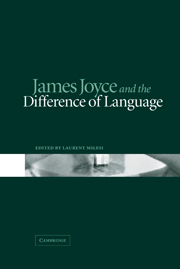Book contents
- Frontmatter
- Contents
- List of contributors
- Acknowledgements
- List of abbreviations
- Chapter 1 Introduction: language(s) with a difference
- Chapter 2 Syntactic glides
- Chapter 3 ‘Cypherjugglers going the highroads’: Joyce and contemporary linguistic theories
- Chapter 4 Madonnas of Modernism
- Chapter 5 Theoretical modelling: Joyce's women on display
- Chapter 6 The lapse and the lap: Joyce with Deleuze
- Chapter 7 ‘sound sense’; or ‘tralala’ / ‘moocow’: Joyce and the anathema of writing
- Chapter 8 Language, sexuality and the remainder in A Portrait of the Artist as a Young Man
- Chapter 9 Border disputes
- Chapter 10 Errors and expectations: the ethics of desire in Finnegans Wake
- Chapter 11 Ex sterco Dantis: Dante's post-Babelian linguistics in the Wake
- Chapter 12 No symbols where none intended: Derrida's war at Finnegans Wake
- Works cited
- Index
Chapter 5 - Theoretical modelling: Joyce's women on display
Published online by Cambridge University Press: 22 September 2009
- Frontmatter
- Contents
- List of contributors
- Acknowledgements
- List of abbreviations
- Chapter 1 Introduction: language(s) with a difference
- Chapter 2 Syntactic glides
- Chapter 3 ‘Cypherjugglers going the highroads’: Joyce and contemporary linguistic theories
- Chapter 4 Madonnas of Modernism
- Chapter 5 Theoretical modelling: Joyce's women on display
- Chapter 6 The lapse and the lap: Joyce with Deleuze
- Chapter 7 ‘sound sense’; or ‘tralala’ / ‘moocow’: Joyce and the anathema of writing
- Chapter 8 Language, sexuality and the remainder in A Portrait of the Artist as a Young Man
- Chapter 9 Border disputes
- Chapter 10 Errors and expectations: the ethics of desire in Finnegans Wake
- Chapter 11 Ex sterco Dantis: Dante's post-Babelian linguistics in the Wake
- Chapter 12 No symbols where none intended: Derrida's war at Finnegans Wake
- Works cited
- Index
Summary
It could be said that Joyce set himself the project of bringing about the death of the novel by writing a series of novels so exemplary that there would be nothing more left to do. Joyce's linguistic experiments seem to push the very limits of literary language as far as they can go. In Joyce's hands, literature appears to be exhausting itself through its own example, insofar as his exemplary oeuvre reads like a mini-history of the novel: from realist birth (A Portrait of the Artist as a Young Man), through modernist middle age (Ulysses), to postmodern death (Finnegans Wake). And yet, however exemplary these texts may be, they obviously have not brought about an end to the novel, the report of whose death has always been greatly exaggerated. More examples of it are being written than ever before, and literary language may yet prove inexhaustible or at least infinitely recyclable.
What remains strikingly exemplary about Joyce's work, though, is that it continues to lend itself surprisingly well to being an example of just about every literary theory. Critics never cease hailing Joyce as the prime example of their theory put into practice, as if his novels permitted us to look at them through whatever theoretical lens we like. Structuralism, semiotics, New Criticism, New Historicism, feminism, postcolonial studies, pretty much all of narratology, and anything roughly considered poststructuralism – including Lacanian psychoanalysis and deconstruction – have all turned to Joyce as an example.
- Type
- Chapter
- Information
- James Joyce and the Difference of Language , pp. 79 - 96Publisher: Cambridge University PressPrint publication year: 2003



